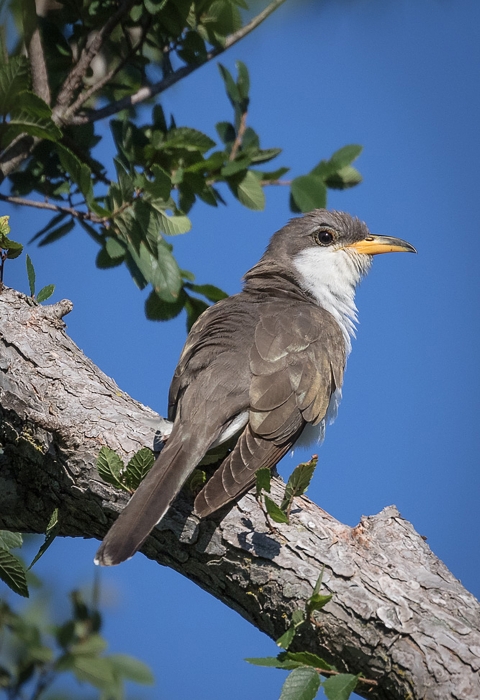Overview
Yellow-billed cuckoos are fairly large, long and slim birds. The mostly yellow bill is almost as long as the head, thick and slightly downcurved. They have a flat head, thin body and very long tail. Wings appear pointed and swept back in flight.
In the west, much of the riparian riparian
Definition of riparian habitat or riparian areas.
Learn more about riparian habitat that is preferred by yellow-billed cuckoos has been converted to farmland and housing, which has lead to population declines and the possible extirpation of cuckoos from British Columbia, Washington, Oregon and Nevada. Once common in the California Central Valley, as well as coastal valleys and riparian habitats east of the Sierra Nevada, habitat loss now constrains the California breeding population to small numbers of birds.
As long-distance, nocturnal migrants, yellow-billed cuckoos are also vulnerable to collisions with tall buildings, cell towers, radio antennas, wind turbines and other structures.Yellow-billed cuckoo populations declined by 1.6% per year between 1966 and 2010. Partners in Flight estimates the global breeding population at about 9 million, with 84% breeding in the United States, 10% in Mexico and none in Canada.
Scientific Name
Identification Numbers
Characteristics
Habitat
Yellow-billed cuckoos use wooded habitat with dense cover and water nearby, including woodlands with low, scrubby, vegetation, overgrown orchards, abandoned farmland and dense thickets along streams and marshes. In the midwest, look for cuckoos in shrublands of mixed willow and dogwood, and in dense stands of small trees such as American elm. In the central and eastern United States, yellow-billed cuckoos nest in oaks, beech, hawthorn and ash. In the west, nests are often placed in willows along streams and rivers, with nearby cottonwoods serving as foraging sites.
Food
Caterpillars top the list of yellow-billed cuckoo prey, with an individual cuckoo eating thousands of caterpillars per season. On the East Coast, periodic outbreaks of tent caterpillars draw cuckoos to eat as many as 100 caterpillars in one sitting. Fall webworms and the larvae of gypsy, brown-tailed and white-marked tussock moths are also part of the cuckoos lepidopteran diet, which is often supplemented with beetles, ants and spiders. They take advantage of the annual outbreaks of cicadas, katydids and crickets, and will hop to the ground to chase frogs and lizards. In summer and fall, cuckoos forage on small wild fruits, including elderberries, blackberries and wild grapes. In winter, fruit and seeds become a larger part of their diet.
Behavior
Yellow-billed cuckoos breed throughout much of the eastern and central United States, winter almost entirely in South America east of the Andes and migrate through Central America. The western subspecies (C.a. occidentalis) has disappeared over much of the western United States and now occurs as a rare breeder in California, Arizona, New Mexico and west Texas.
Life Cycle
The male and female yellow-billed cuckoo build a flat, oblong platform nest together that they construct of loose sticks, using twigs they collect from the ground or snapped from nearby trees and shrubs. The pair may line the nest sparingly with strips of bark or dried leaves. The male sometimes continues bringing in nest materials after incubation has begun. Pairs may visit prospective nest sites multiple times before building a nest together.
Physical Characteristics
Yellow-billed cuckoos are warm brown above and clean whitish below. Their blackish face mask is accompanied by a yellow eye-ring. In flight, the outer part of the wings flash rufous. From below, the tail has wide white bands and narrower black ones.
Timeline
Explore the information available for this taxon's timeline. You can select an event on the timeline to view more information, or cycle through the content available in the carousel below.
47 Items